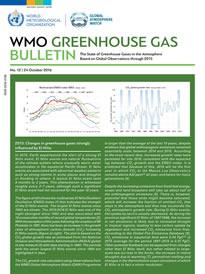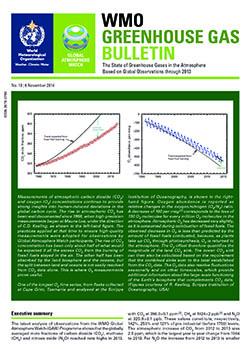Greenhouse Gas Research
The Global Atmosphere Watch (GAW) programme promotes systematic and reliable observations of the global atmospheric environment and utilization of these observations together with models to understand the processes that drive changes in atmospheric chemical composition. Of the long-lived greenhouse gases that are directly affected by anthropogenic activities, carbon dioxide (CO2) has the largest total radiative effect, followed by methane (CH4), nitrous oxide (N2O) and chlorofluorocarbons (CFCs). Reliable long-term estimates of sources and sinks appropriate to particular emission management scenarios require very high accuracy and precision observations of the abundance and the vertical distribution of CO2 and CH4 as well as their isotopes and related reactive (O3, CO, NOx, SO2, VOC, etc.) gases.
The following gases are addressed in the group of greenhouse gases in GAW:
- Carbon Dioxide (CO2) (including isotopic composition and O2/N2 Ratios)
- Methane (CH4) and its isotopic composition
- Nitrous Oxide (N2O)
- Halocarbons and SF6
- Molecular Hydrogen (H2)
The data are collected and distributed by the World Data Centre for Greenhouse Gases (WDCGG) at the Japan Meteorological Agency. The GAW Scientific Advisory Group for Greenhouse Gases (SAG-GHG) advises on the programme development. GAW issues the annual Greenhouse Gas Bulletin, which reports on the latest trends and atmospheric burdens of the most influential, long-lived greenhouse gases (CO2, CH4, N2O), as well as a summary of the contributions of the lesser gases.
WMO started working on a development of an Integrated Global Greenhouse Gas Information System (IG3IS) in 2013 as a "science-for-services" initiative and developed under its umbrella a number of the important products .
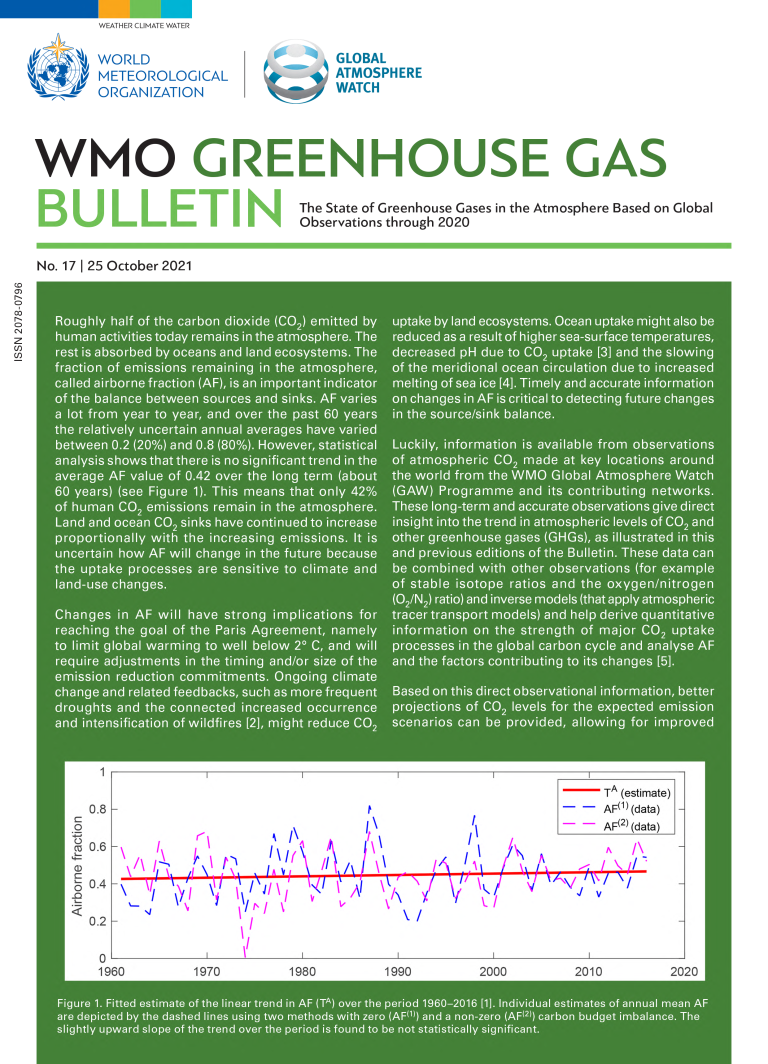
| ||
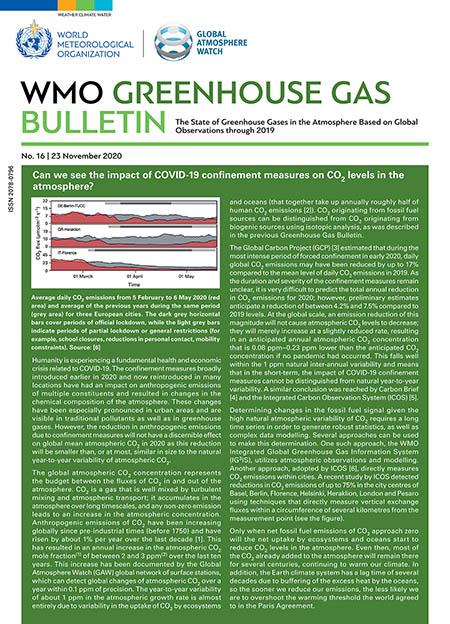
| 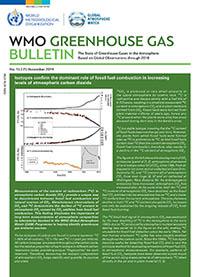
|

|

| ||
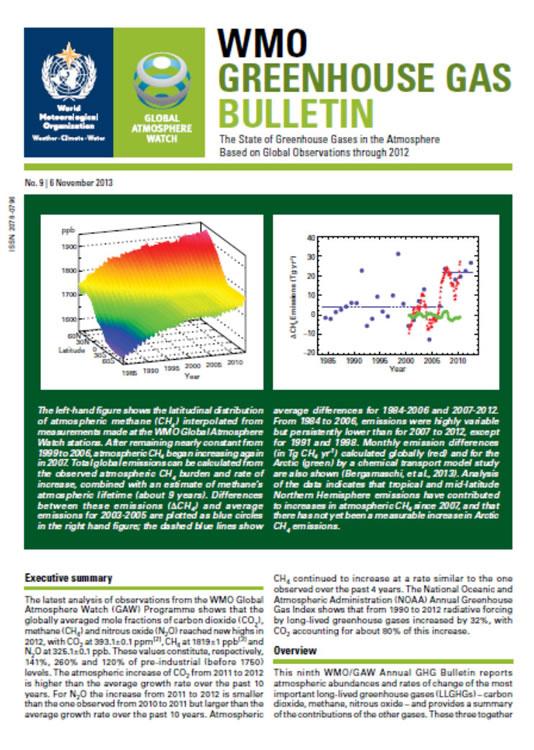
| 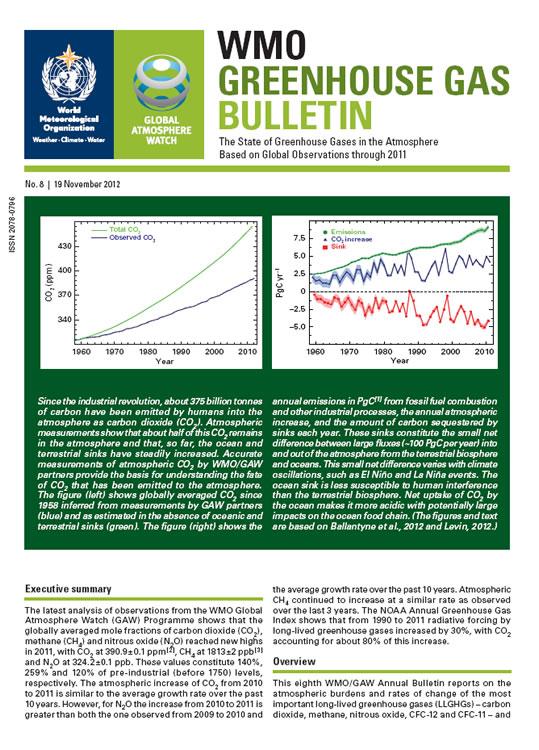
| |
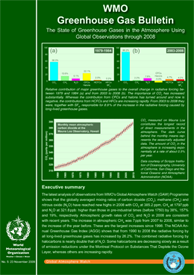
| ||

| 
| 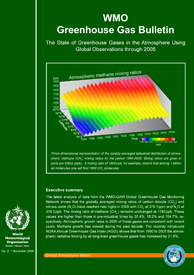
|
The greenhouse effect
The Earth has a natural greenhouse effect due to trace amounts of water vapour (H2O), carbon dioxide (CO2), methane (CH4) and nitrous oxide (N2O) in the atmosphere. These gases let the solar radiation reach the Earth’s surface, but they absorb infrared radiation emitted by the Earth and thereby lead to the heating of the surface of the planet. One needs to distinguish between the natural greenhouse effect and the enhanced greenhouse effect.
The natural greenhouse effect is caused by the natural amounts of greenhouse gases, and is vital to life. In the absence of the natural greenhouse effect the surface of the Earth would be approximately 33 degrees Celsius cooler.
The enhanced greenhouse effect refers to the additional radiative forcing resulting from increased concentrations of greenhouse gases induced by human activities. The main greenhouse gases whose concentrations are rising are carbon dioxide, methane, nitrous oxide, hydrochlorofluorocarbons (HCFCs), hydrofluorocarbons (HFCs) and ozone in the lower atmosphere. This phenomenon is explained in the video.
Greenhouse gas observations
Greenhouse gas observations are carried out at a large number of sites on all continents. The most recent map is shown in the last issue of the WMO Greenhouse Bulletin. The stations are described in the GAW Station Information System (GAWSIS).
Fifty WMO member countries have contributed CO2 data to the GAW World Data Centre for Greenhouse Gases (WDCGG). Approximately 50% of the measurement records submitted to WDCGG are obtained at sites in the NOAA ESRL cooperative air sampling network. The rest of the network is maintained by Australia, Canada, China, Japan and many European countries.
List of the WMO Global Atmosphere Watch (GAW) monitoring stations that contribute data to the Greenhouse Gas Bulletins is distributed as a List of Contributors on the WDCGG web page.
Meetings on Carbon Dioxide, Other Greenhouse Gases, and Related Measurement Techniques (GGMT)
20th WMO/IAEA Meeting on Carbon Dioxide, Other Greenhouse Gases, and Related Measurement Techniques (GGMT-2019), Jeju, Republic of Korea, 2-6 September 2019
19th WMO/IAEA Meeting on Carbon Dioxide, Other Greenhouse Gases, and Related Measurement Techniques (GGMT-2017), Empa, Duebendorf, Switzerland, 27-31 August 2017
18th WMO/IAEA Meeting on Carbon Dioxide, Other Greenhouse Gases and Related Measurement Techniques (GGMT-2015), La Jolla, USA, 13-17 September 2015 (presentations)
17th WMO/IAEA Meeting on Carbon Dioxide, Other Greenhouse Gases and Relater Measurement Techniques (GGMT-2013), Beijing, China, 10-13 June 2013
16th WMO/IAEA Meeting on Carbon Dioxide, Other Greenhouse Gases, and Related Measurement Techniques (GGMT) (Wellington, New Zealand, 25th – 28th October 2011)
15th WMO/IAEA Meeting of Experts on Greenhouse Gas Measurements, Jena, Germany, 7-11 September 2009.

